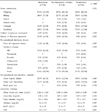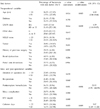1. Fishman JA, Rubin RH. Infection in organ-transplant recipients. N Engl J Med. 1998. 338:1741–1751.
2. Snydman DR. Infection in solid organ transplantation. Transpl Infect Dis. 1999. 1:21–28.
3. Kwak EJ, Kusne S. Bowden RA, Ljungman P, Paya CV, editors. Risks and epidemiology of infections after liver transplantation. Transplant infection. 2003. 2nd ed. Philadelphia: Lippincott Williams & Wilkins;120.
4. Wade JJ, Rolando N, Hayllar K, Philpott-Howard J, Casewell MW, Williams R. Bacterial and fungal infections after liver transplantation: an analysis of 284 patients. Hepatology. 1995. 21:1328–1336.

5. Singh N, Gayowski T, Wagener MM, Marino IR. Predictors and outcome of early-versus late-onset major bacterial infections in liver transplant recipients receiving tacrolimus (FK506) as primary immunosuppression. Eur J Clin Microbiol Infect Dis. 1997. 16:821–826.

6. Singh N, Wagener MM, Obman A, Cacciarelli TV, de Vera ME, Gayowski T. Bacteremias in liver transplant recipients: shift toward gram-negative bacteria as predominant pathogens. Liver Transpl. 2004. 10:844–849.

7. George DL, Arnow PM, Fox AS, Baker AL, Thistlethwaite JR, Emond JC, et al. Bacterial infection as a complication of liver transplantation: epidemiology and risk factors. Rev Infect Dis. 1991. 13:387–396.

8. Kusne S, Dummer JS, Singh N, Iwatsuki S, Makowka L, Esquivel C, et al. Infections after liver transplantation. An analysis of 101 consecutive cases. Medicine (Baltimore). 1988. 67:132–143.
9. Wagener MM, Yu VL. Bacteremia in transplant recipients: a prospective study of demographics, etiologic agents, risk factors, and outcomes. Am J Infect Control. 1992. 20:239–247.
10. Paya CV, Hermans PE, Washington JA 2nd, Smith TF, Anhalt JP, Wiesner RH, et al. Incidence, distribution, and outcome of episodes of infection in 100 orthotopic liver transplantations. Mayo Clin Proc. 1989. 64:555–564.
11. Kawecki D, Chmura A, Pacholczyk M, Lagiewska B, Adadynski L, Wasiak D, et al. Etiological agents of bacteremia in the early period after liver transplantation. Transplant Proc. 2007. 39:2816–2821.

12. Singh N, Paterson DL, Gayowski T, Wagener MM, Marino IR. Predicting bacteremia and bacteremic mortality in liver transplant recipients. Liver Transpl. 2000. 6:54–61.
13. Annual Report 2007. Korean Network for Organ Sharing. accessed 1 June 2008. Available from: URL:
http://www.konos.go.kr.
14. Cho WH, Kim YS. Landmarks in clinical transplantation in Korea. Yonsei Med J. 2004. 45:963–967.

15. Moon DB, Lee SG. Adult-to-adult living donor liver transplantation at the Asan medical center. Yonsei Med J. 2004. 45:1162–1168.

16. Chang FY, Singh N, Gayowski T, Wagener MM, Marino IR. Fever in liver transplant recipients: changing spectrum of etiologic agents. Clin Infect Dis. 1998. 26:59–65.
17. Garner JS, Jarvis WR, Emori TG, Horan TC, Hughes JM. CDC definitions for nosocomial infections, 1988. Am J Infect Control. 1988. 16:128–140.

18. Simon DM, Levin S. Infectious complications of solid organ transplantations. Infect Dis Clin North Am. 2001. 15:521–549.

19. Habib S, Berk B, Chang CC, Demetris AJ, Fontes P, Dvorchik I, et al. MELD and prediction of post-liver transplantation survival. Liver Transpl. 2006. 12:440–447.

20. Mellors JW, Horwitz RI, Harvey MR, Horwitz SM. A simple index to identify occult bacterial infection in adults with acute unexplained fever. Arch Intern Med. 1987. 147:666–671.

21. Candel FJ, Grima E, Matesanz M, Cervera C, Soto G, Almela M, et al. Bacteremia and septic shock after solid-organ transplantation. Transplant Proc. 2005. 37:4097–4099.

22. Bedini A, Codeluppi M, Cocchi S, Guaraldi G, Di Benedetto F, Venturelli C, et al. Gram-positive bloodstream infections in liver transplant recipients: incidence, risk factors, and impact on survival. Transplant Proc. 2007. 39:1947–1949.

23. Al Riyami D, Alam A, Badovinac K, Ivis F, Trpeski L, Cantarovich M. Decreased survival in liver transplant patients requiring chronic dialysis: a Canadian experience. Transplantation. 2008. 85:1277–1280.










 PDF
PDF ePub
ePub Citation
Citation Print
Print



 XML Download
XML Download